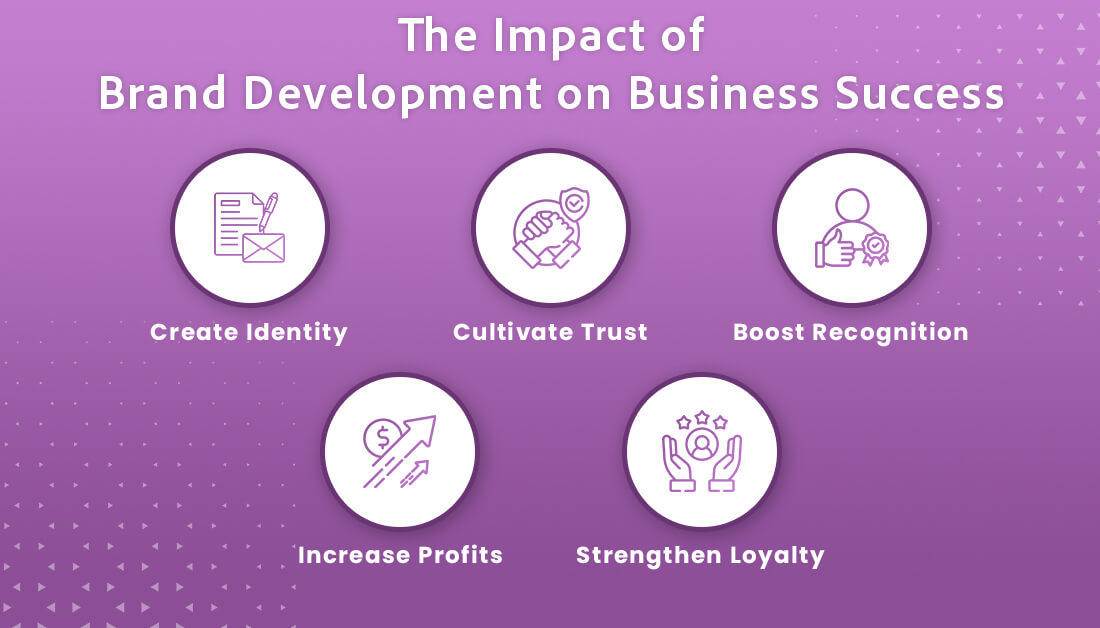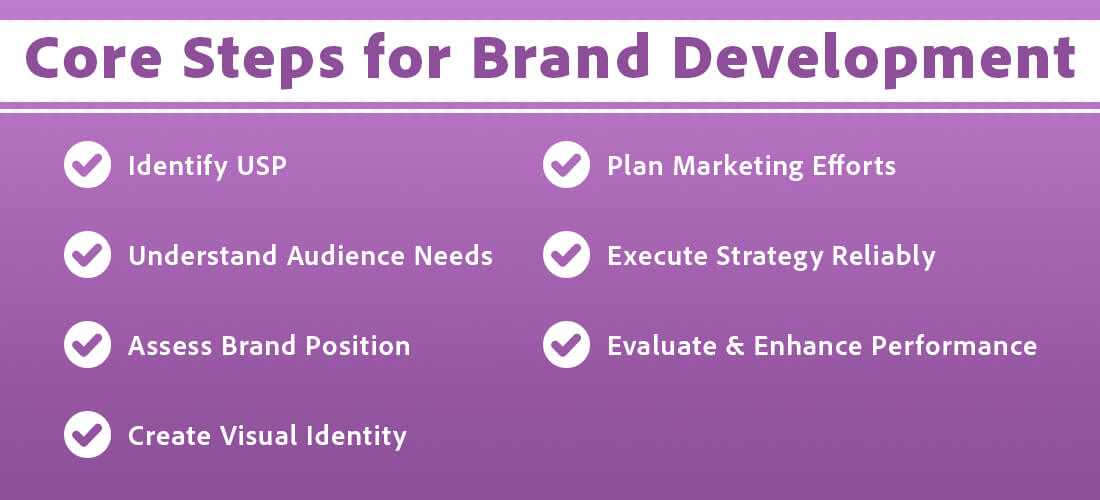
“A word is a word, a picture is worth a thousand words, but a brand is worth a million,” – Tony Hsieh.
It signifies that brand is the most significant investment that entrepreneurs make in their lives. The investment pays off with credibility, reliability, and quality when everything is done with great attention. The solid foundation makes the brand unforgettable and shines through. However, achieving excellence with a growth strategy is possible for brands.
Thankfully, brand development helps. It’s a process of making a brand continuously survive and thrive to accomplish desired goals. In simple words, brand development is a long and continuous process of aligning a brand with objectives, expressing values, and strengthening the brand according to its mission. So, brand development must be on the top of the to-do list as it creates a powerful brand that people like to buy and experience consciously.
But actual brand development doesn’t occur on paper. A lot goes into breathing life into the procedure of brand development with a reasonably designed growth strategy. We will dive deeper to understand the importance of brand development, how to start with brand development, and a couple of ways to measure success with a brand development strategy.
Table of Contents
What’s the Significance of Brand Development?
Brand development is significant and contributes to the greater good of the business. The reasons mentioned make this clear, highlighting the importance of brand building.
Create a business identity
Brand development is so powerful that it makes brand products heard, seen, and remembered with the brand’s name. Investing in it is so successful in some business cases that it has become a way to stay at the top of people’s minds. Even the brand name outshines the product’s name. The best example is the Colgate brand, which is even used to refer to toothpaste in some corners of the world. Coke, Aspirin, and Jacuzzi are famous brands that have developed their brand that have surpassed the actual products and become a business identity.
Build trust
Some brands such as Apple, Nike, and others have established over the years and built a rapport with clientele, which creates a sense of trust in the people’s minds. That’s why people don’t inquire much and readily stand in long queues when they want to purchase their new product. The brand development process involves continuously spreading a message and staying true to the words for a long time, which makes people trust the brand product blindfolded. Remember Disney movies, where parents allow their children to watch without hesitation. So, it’s trust that speaks.
Improve brand recognition
Businesses consistently spread the same message wrapped with branding elements across different channels during brand engineering. The same design assets in story format make the brand more recognizable. The well-thought and designed branding elements make the brand noticeable and leave an indelible impression on people’s minds. For example, the Diesel brand is recognized for its unique visuals.
Surge in business profits
Successful brands receive a lot of respect from the people, and positive responses with continuous market reach expansion result in an improved bottom line. Great fan following leads to more sales. Consistent branding as part of the brand development process increases business profits. Rising valuation levels enable brands to raise more funds easily.
Enhance loyalty rates
Trust is directly proportional to customer retention. With brand development, businesses can turn visitors into potential customers and increase the number of loyal repetitive customers. For example, Starbucks branding brand makes customers so loyal that they drive past several coffee shops to have a cup of coffee at Starbucks. It can be the unique taste or services that make them pay more for Starbucks coffee. Exceeding customer expectations with brand development is a popular way to gain loyalty.
How Can You Measure Success With Brand Development?
The range of benefits makes businesses invest in brand development, but quantifying brand development strategy is more important to ensure it is bringing results as expected or not. That’s where the brand development index—the metric that tells whether spending on marketing is worth it—comes in. There’s a formula that allows businesses to measure success rates.
Brand development index = Total percentage of sales / Total percentage of market reach
when BDI (Brand development index) is high, it indicates product demand is increasing in a particular area. The metric is also used for finding weak points that are negatively impacting product demand and results are getting down.
The Roadmap to Develop a Brand Uniquely
The benefits convince you to get started with brand development. But how can you start brand development that goes on until your business products live? This seven-step guide will let you know how to move ahead with your brand growth strategy.
Define the brand’s USP
What your brand is and what makes it different in the crowded market is essential to clarify to your target audience, key stakeholders, and business employees. This is the brand’s USP that makes brand building, brand development, and online reputation management easier for branding companies, brand development companies, and others.
Businesses can find a brand’s Unique Selling Point (USP) by identifying its position, problems that products/services resolve, and the core idea behind its offerings. A USP is a promise that a brand makes and the value it delivers to customers. Internal assessment helps the team create a message that aligns with the target audience’s needs and meets the gap. Connecting the USP with emotional and social values takes the results to the next level.
Find out what your target audience wants
Understanding target customers and analyzing their needs doesn’t rest on their location, education, age, or other demographic information. Targeting users with a specific product or service requires targeting customers at the micro-level. Customers’ interests, social behavior, lifestyle, and challenges must be identified, which reveals what they want from your brand products.
Personalizing brand products based on target audience needs analysis ensures the brand resonates with target customers’ needs and makes customers love the products. It also eliminates unnecessary marketing spending. If the target audience is happy with the brand, conduct customer surveys to create accurate customer personas.
Check the brand’s positioning
A brand’s positioning is identified with its impression on customers’ minds. For instance, when a product is known by its brand, remember Colgate, a synonym for toothpaste in the oral care industry. Consistently delivering the same message of healthy teeth and bright smiles leads to the brand’s strategic position in the market.
Brand positioning comes in different types, such as Quality-based positioning, wherein a brand like Apple is known for its products’ reliability and durability; convenience-based positioning, which Uber, Airbnb, and other brands have gained fame and name by making customers’ lives easier in distinct ways; and price-based positioning helped Amazon, Walmart, or H&M brands capture more significant market share based on products’ price range. It would help to decide how you want to position the brand based on which factor.
Develop an engaging visual identity
The visual identity of the brand is built based on visual elements such as the brand logo, icons, design aesthetic, typography, and others that change over time with customers’ preferences and behavior. The changes occur gradually and take years to build the visual identity of the brand. However, despite these changes, authenticity helps the brand stay connected with customers consistently.
Checking the pulse of the market and evolving according to customers’ demeanor is good, but looking back to see if refining the visual identity matches the brand’s value is significant. Style guides can be created for businesses to work in an order that makes the brand recognizable using different design elements.
Design a marketing plan
A marketing plan is a bridge connecting the brand and customers by communicating the brand’s message to the customers in a creative and innovative way. There is no one-size-fits-all marketing strategy for different types of businesses. However, getting a couple of things ready makes creating a personalized marketing plan easier.
Market and competition research and analysis help you know your product demand and growth in the niche market. Creating a smart marketing strategy based on SWOT analysis helps reveal the brand’s positioning and then define promotion, price, and people for marketing strategy accordingly. After that, content should be created for marketing that helps maximize ROI. Key metrics such as conversion rate, CLV, search traffic, and engagement rate help measure marketing strategy effectiveness. Remember, marketing budget allocation ensures that the optimal amount is invested, bringing great benefits to the businesses.
Implement brand development strategy consistently
After reaching this stage, remember to pay more attention to every aspect of brand development, from visual element selection to content creation. Whether internally or externally, the brand should consistently spread the same message and voice across all platforms.
It engineers the same brand’s perception irrespective of where your customers are looking at your brand, from website to customer service. It results in improved brand recognition.
Monitor and improve the brand’s performance
After implementing a brand creation strategy, it’s essential to monitor business performance against some metrics. This continuous process helps determine whether the business is progressing as expected or whether the branding strategy needs to be changed. Sentiment analysis is popularly used to assess customer interactions and responses.
Besides, monitoring tools are leveraged to track brand content, keywords, and hashtags to analyze the brand’s performance in real time. Google alerts and Ahrefs-like tools help to know it in detail. Customer support also provides valuable data that helps enhance strategy to build a brand.
Ready to Build a Brand Growth Strategy?
In an era where new brands are entering rapidly and dividing customers’ attention, not letting them succeed, brand development is a step forward to increasingly capturing a larger market share. From unique visual identity and compelling brand content creation to online reputation management and customer loyalty- the by-product of brand development lays the brand’s strong foundation. Furthermore, it helps connect with the target audience at an emotional level when they are overwhelmed with immense possibilities or options.
Partnering with experienced branding companies can significantly increase this effect, leveraging their expertise to create a brand development strategy that not only improves brand awareness but also strengthens customers’ trust in the brand. It’s high time to connect with brand experts and start this transformative journey. Let’s start!
 Gillian Harper
| Apr 8, 2024
Gillian Harper
| Apr 8, 2024
A professionally engaged blogger, an entertainer, dancer, tech critic, movie buff and a quick learner with an impressive personality! I work as a Senior Process Specialist at Topdevelopers.co as I can readily solve business problems by analyzing the overall process. I’m also good at building a better rapport with people!

